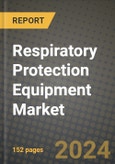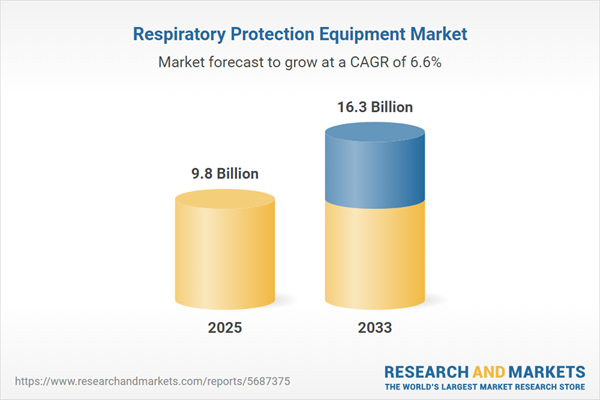The Respiratory Protection Equipment Market serves as a critical segment of the global personal protective equipment (PPE) industry, providing devices designed to safeguard users from inhaling harmful airborne contaminants such as dust, fumes, vapors, pathogens, and gases. The market includes a broad range of products, including air-purifying respirators (APR), powered air-purifying respirators (PAPR), supplied-air respirators (SAR), and self-contained breathing apparatuses (SCBA), commonly used across industries such as healthcare, construction, mining, manufacturing, firefighting, and oil & gas. Driven by increasing industrialization, rising workplace safety standards, and the ongoing risk of infectious diseases, the demand for effective respiratory protection remains robust. Moreover, regulatory bodies such as OSHA, NIOSH, and the European Agency for Safety and Health at Work continue to mandate the use of certified respiratory gear in high-risk environments, reinforcing market stability. As awareness of occupational health and airborne threats grows globally, so too does investment in innovation, comfort, and durability in respiratory equipment.
In 2024, the respiratory protection equipment market saw sustained demand across healthcare, industrial, and emergency response sectors. Healthcare facilities remained major users of N95 respirators and surgical masks, driven by respiratory infection control measures and enhanced PPE protocols. Industrial sectors increasingly adopted PAPRs and half-facepiece respirators for welding, painting, and chemical handling, with manufacturers improving ergonomic design and battery life. Fire departments and hazardous materials teams upgraded to lighter and more durable SCBA systems featuring integrated communication tools. Sustainability also became a key focus, with reusable respirators and recyclable filter cartridges gaining traction among environmentally conscious organizations. Meanwhile, developing regions saw expansion in domestic production of respiratory PPE, reducing dependency on imports and strengthening supply chain resilience. Technological enhancements - such as built-in sensors for air quality monitoring and fit detection - began integrating into high-end respirators, signaling the market’s gradual shift toward smart protection solutions.
Looking ahead to 2025 and beyond, the respiratory protection equipment market is expected to advance through smart technologies, increased automation, and customized solutions for specific industrial and healthcare needs. AI-enabled respirators capable of real-time hazard detection, fit verification, and user compliance tracking will see wider adoption in high-risk environments. As environmental and occupational safety regulations tighten globally, demand for next-gen PAPRs and full-face respirators will grow in industries with exposure to hazardous particulates and chemicals. Portable, wearable devices designed for comfort during extended use will dominate R&D efforts, especially in sectors with long shifts. Additionally, climate change-related events - such as wildfires and toxic air pollution - are anticipated to expand the use of respiratory protection among civilians and emergency responders. However, cost constraints, particularly in small and medium enterprises (SMEs), may hinder adoption of premium, tech-enabled equipment, highlighting the continued need for affordable yet effective respiratory safety solutions.
Key Insights: Respiratory Protection Equipment Market
- Smart respirators with embedded sensors for real-time air quality monitoring and compliance tracking are gaining popularity in industrial safety applications.
- Reusable and sustainable respiratory protection devices are being developed to meet environmental targets and reduce PPE waste.
- Lightweight SCBA systems with integrated voice communication are enhancing operational efficiency in firefighting and hazardous material response.
- Customized fit technologies and ergonomic designs are improving comfort and usage compliance among workers in high-exposure industries.
- Localized manufacturing and PPE stockpiling strategies are being prioritized to build resilience against future pandemics and supply chain disruptions.
- Stringent workplace safety regulations across construction, mining, manufacturing, and healthcare sectors mandate the use of certified respiratory protection equipment.
- Ongoing risks from infectious diseases and airborne hazards are driving sustained demand for high-efficiency filtration respirators in medical and community settings.
- Technological advancements in materials, comfort, and filtration are enhancing product performance and user compliance.
- Rising awareness of occupational health risks and air quality issues is fueling growth in both industrial and personal use segments of the market.
- The high cost of advanced respiratory protection equipment, including PAPRs and SCBAs, poses a barrier for small enterprises and low-income markets, limiting access to optimal worker safety solutions despite regulatory requirements.
Respiratory Protection Equipment Market Segmentation
By Product:
- APR
- Supplied Air Respirators
By Filter Type:
- Particle
- Gas And Vapor
- Compiled Filters
By Distribution Channel:
- Direct And institutional Sales
- Retail Sales
By End-User:
- Oil And Gas
- Fire Services
- Petrochemical And Chemical
- Industrial
- Pharmaceuticals
- Construction
- Healthcare
- Mining
- Other End-Users
By Geography:
- North America (USA, Canada, Mexico)
- Europe (Germany, UK, France, Spain, Italy, Rest of Europe)
- Asia-Pacific (China, India, Japan, Australia, Vietnam, Rest of APAC)
- The Middle East and Africa (Middle East, Africa)
- South and Central America (Brazil, Argentina, Rest of SCA)
Respiratory Protection Equipment Market Size Data, Trends, Growth Opportunities, and Restraining Factors:
- This comprehensive Respiratory Protection Equipment market report delivers updated market size estimates from 2024 to 2034, offering in-depth analysis of the latest Respiratory Protection Equipment market trends, short-term and long-term growth drivers, competitive landscape, and new business opportunities. The report presents growth forecasts across key Respiratory Protection Equipment types, applications, and major segments, alongside detailed insights into the current Respiratory Protection Equipment market scenario to support companies in formulating effective market strategies.
- The Respiratory Protection Equipment market outlook thoroughly examines the impact of ongoing supply chain disruptions and geopolitical issues worldwide. Factors such as trade tariffs, regulatory restrictions, production losses, and the emergence of alternatives or substitutes are carefully considered in the Respiratory Protection Equipment market size projections. Additionally, the analysis highlights the effects of inflation and correlates past economic downturns with current Respiratory Protection Equipment market trends, providing actionable intelligence for stakeholders to navigate the evolving Respiratory Protection Equipment business environment with precision.
Respiratory Protection Equipment Market Competition, Intelligence, Key Players, and Winning Strategies to 2034:
- The 2025 Respiratory Protection Equipment Market Research Report identifies winning strategies for companies to register increased sales and improve market share.
- Opinions from senior executives from leading companies in the Respiratory Protection Equipment market are imbibed thoroughly and the Respiratory Protection Equipment industry expert predictions on the economic downturn, technological advancements in the Respiratory Protection Equipment market, and customized strategies specific to a product and geography are mentioned.
- The Respiratory Protection Equipment market report is a source of comprehensive data and analysis of the industry, helping businesses to make informed decisions and stay ahead of the competition. The Respiratory Protection Equipment market study assists investors in analyzing On Respiratory Protection Equipment business prospects by region, key countries, and top companies' information to channel their investments.
- The report provides insights into consumer behavior and preferences, including their buying patterns, brand loyalty, and factors influencing their purchasing decisions. It also includes an analysis of the regulatory environment and its impact on the Respiratory Protection Equipment industry. Shifting consumer demand despite declining GDP and burgeoning interest rates to control surging inflation is well detailed.
What's Included in the Report?
- Global Respiratory Protection Equipment market size and growth projections, 2024-2034
- North America Respiratory Protection Equipment market size and growth forecasts, 2024-2034 (United States, Canada, Mexico)
- Europe market size and growth forecasts, 2024-2034 (Germany, France, United Kingdom, Italy, Spain)
- Asia-Pacific Respiratory Protection Equipment market size and growth forecasts, 2024-2034 (China, India, Japan, South Korea, Australia)
- Middle East Africa Respiratory Protection Equipment market size and growth estimate, 2024-2034 (Middle East, Africa)
- South and Central America Respiratory Protection Equipment market size and growth outlook, 2024-2034 (Brazil, Argentina, Chile)
- Respiratory Protection Equipment market size, share and CAGR of key products, applications, and other verticals, 2024-2034
- Short- and long-term Respiratory Protection Equipment market trends, drivers, challenges, and opportunities
- Respiratory Protection Equipment market insights, Porter’s Five Forces analysis
- Profiles of 5 leading companies in the industry - overview, key strategies, financials, product portfolio and SWOT analysis
- Latest market news and developments
Key Questions Answered in This Report:
- What is the current Respiratory Protection Equipment market size at global, regional, and country levels?
- What is the market penetration of different types, Applications, processes/technologies, and distribution/sales channels of the Respiratory Protection Equipment market?
- What will be the impact of economic slowdown/recission on Respiratory Protection Equipment demand/sales?
- How has the global Respiratory Protection Equipment market evolved in past years and what will be the future trajectory?
- What is the impact of growing inflation, Russia-Ukraine war on the Respiratory Protection Equipment market forecast?
- What are the Supply chain challenges for Respiratory Protection Equipment?
- What are the potential regional Respiratory Protection Equipment markets to invest in?
- What is the product evolution and high-performing products to focus in the Respiratory Protection Equipment market?
- What are the key driving factors and opportunities in the industry?
- Who are the key players in Respiratory Protection Equipment market and what is the degree of competition/Respiratory Protection Equipment market share?
- What is the market structure /Respiratory Protection Equipment Market competitive Intelligence?
Available Customizations:
The standard syndicate report is designed to serve the common interests of Respiratory Protection Equipment Market players across the value chain, and include selective data and analysis from entire research findings as per the scope and price of the publication.However, to precisely match the specific research requirements of individual clients, several customization options are offered to include the data and analysis of interest in the final deliverable.
Some of the customization requests are as mentioned below:
- Segmentation of choice - Clients can seek customization to modify/add a market division for types/applications/end-uses/processes of their choice.
- Respiratory Protection Equipment Pricing and Margins Across the Supply Chain, Respiratory Protection Equipment Price Analysis / International Trade Data / Import-Export Analysis.
- Supply Chain Analysis, Supply-Demand Gap Analysis, PESTLE Analysis, Macro-Economic Analysis, and other Respiratory Protection Equipment market analytics.
- Processing and manufacturing requirements, Patent Analysis, Technology Trends, and Product Innovations.
- Further, the client can seek customization to break down geographies as per their requirements for specific countries/country groups such as South East Asia, Central Asia, Emerging and Developing Asia, Western Europe, Eastern Europe, Benelux, Emerging and Developing Europe, Nordic countries, North Africa, Sub-Saharan Africa, Caribbean, The Middle East and North Africa (MENA), Gulf Cooperation Council (GCC) or any other.
- Capital Requirements, Income Projections, Profit Forecasts, and other parameters to prepare a detailed project report to present to Banks/Investment Agencies.
Additional support:
- All the data presented in tables and charts of the report is provided in a separate Excel document
- Print authentication allowed on purchase of online versions
- 10% free customization to include any specific data/analysis to match the requirement
- 7 days of analyst support
This product will be delivered within 1-3 business days.
Table of Contents
Table Information
| Report Attribute | Details |
|---|---|
| No. of Pages | 150 |
| Published | August 2025 |
| Forecast Period | 2025 - 2033 |
| Estimated Market Value ( USD | $ 9.8 Billion |
| Forecasted Market Value ( USD | $ 16.3 Billion |
| Compound Annual Growth Rate | 6.6% |
| Regions Covered | Global |









